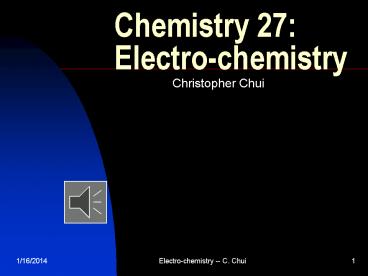Chemistry 27: Electro-chemistry
1 / 11
Title:
Chemistry 27: Electro-chemistry
Description:
Electro-chemistry -- C. Chui. 9. Electrolysis and Effects of Conditions on Cells and Energy ... Electro-chemistry -- C. Chui. 11. Quantitative Electrochemistry ... –
Number of Views:541
Avg rating:3.0/5.0
Title: Chemistry 27: Electro-chemistry
1
Chemistry 27 Electro-chemistry
- Christopher Chui
2
Circuits and Conductivity
- A complete metal circuit allows electrons to flow
- A galvanometer measures electric current
- Electric current is the flow of charged particles
- A salt bridge is a U-tube containing ionic
substance in solution - The galvanometer registers the current flow
between two different metals placed in a salt
solution
3
Conduction and Potential Difference
- Metallic conduction or electronic conduction
refers to the movement of electrons through a
metal - Electric potential difference is measured in
volts - The rate of electron flow is measured in amperes
- Electrolytes are substances whose solutions
conduct electricity - Molten salts and solutions of acids, bases, and
salts conduct electricity - Conduction that takes place by the migration of
ions is called electrolytic conduction - Positive ions are called cations negative ions
are anions
4
Electrode Reactions
- Positive ions (cations) are attracted to the
cathode - At the cathode, positive ions are reduced by
gaining electrons Na e- ? Na - Negative ions (anions) are attracted to the anode
- At the anode, negative ions are oxidized by
losing electrons 2 Cl- ? Cl2 2 e- - In a cell, oxidation and reduction occur as
separate half-reactions at the same time - Electrolysis is the use of an electric current to
produce a chemical change
5
Electrolysis of a Salt Solution
- In the electrolysis of a concentrated NaCl
solution, H2 is produced at the cathode, and Cl2
is produced at the anode - 2 NaCl 2 H2O ? 2 NaOH H2 Cl2
- Electronic conduction is the movement of
electrons through a metal - Electrolytic conduction is the migration of ions
through the liquid between the electrodes
6
Voltaic Cells
- A voltaic cell converts chemical energy into
electric energy - A voltaic cell consists of zinc metal in a
solution of zinc ions connected with a salt
bridge and an external circuit to copper metal in
a solution of copper ions - Reactions take place at separate electrodes.
Electrons flow from the anode to the cathode in
the external circuit - When using the shorthand method of representing
cells, place the anode on the left
7
Redox and Standard Electrode Potentials
- The hydrogen (reference) half-cell is assigned
zero potential 2 H(aq) 2 e- ?? H2 (g) - The hydrogen half-cell consists of a sheet of Pt
immersed in 1M solution of H ions. H2 gas is
bubbled into the solution at a pressure of 101.3
kPa. The H2 molecules are adsorbed on the Pt
surface and form the electrode - Potentials vary with temp T, pressure P, and
conc. - Half-cell potential tables are useful for
predicting the direction of chemical reactions - Electrons flow from donor (anode) to acceptor
(cathode)
8
Cell Potential
- Standard reduction potential is an intensive
property - A negative voltage for a redox reaction means the
reaction is not spontaneous, and the reverse
reaction will occur - Magnesium has a higher potential than copper
- If a reaction yields a negative voltage, the
reverse reaction yields a positive voltage - The standard reduction potential indicates a
tendency of the half-reaction to gain electrons.
The greater (more ve) the voltage, the greater
the tendency to gain electrons
9
Electrolysis and Effects of Conditions on Cells
and Energy
- German chemist, Nernst, found
- EE0 (RT)/nF ln(products conc/reactants conc)
- R is the gas constant T in K F factor from volt
to J 96485 ln is natural log n is the number
of electrons transferred - After simplification, EE0 - 0.05916/n
log(prod/react)
10
pH Meter, Energy and Electric Cells
- The Nernest equation can be applied to half-cells
or to an entire cell EE0-2.3 RT log K/(nF) - E is a linear function of pH
- The pH meter makes use of a hydrogen ion
electrode and a reference electrode, or a
combination electrode - At equilibrium, E0, therefore, 2.3 RT log K
nFE0 - DG0 -nFE0
11
Quantitative Electrochemistry
- Cell voltage can be used to find 1) Gibbs free
energy change 2) tendency to gain electrons 3)
tendency to lose electrons 4) equilibrium
constant, Keq - A reaction tends to be spontaneous if Keq gtgt1,
E0gt0, and DG lt 0 - 1 coul is the amount of electricity produced by 1
amp flowing for 1 sec 96485 coul 1 mole of
electrons - Cu 2 2 e- ?Cu
- 2 moles of electrons will reduce 1 mole of Cu 2
to Cu - Cr in Cr2O7 2- has an oxidation number of 6






























